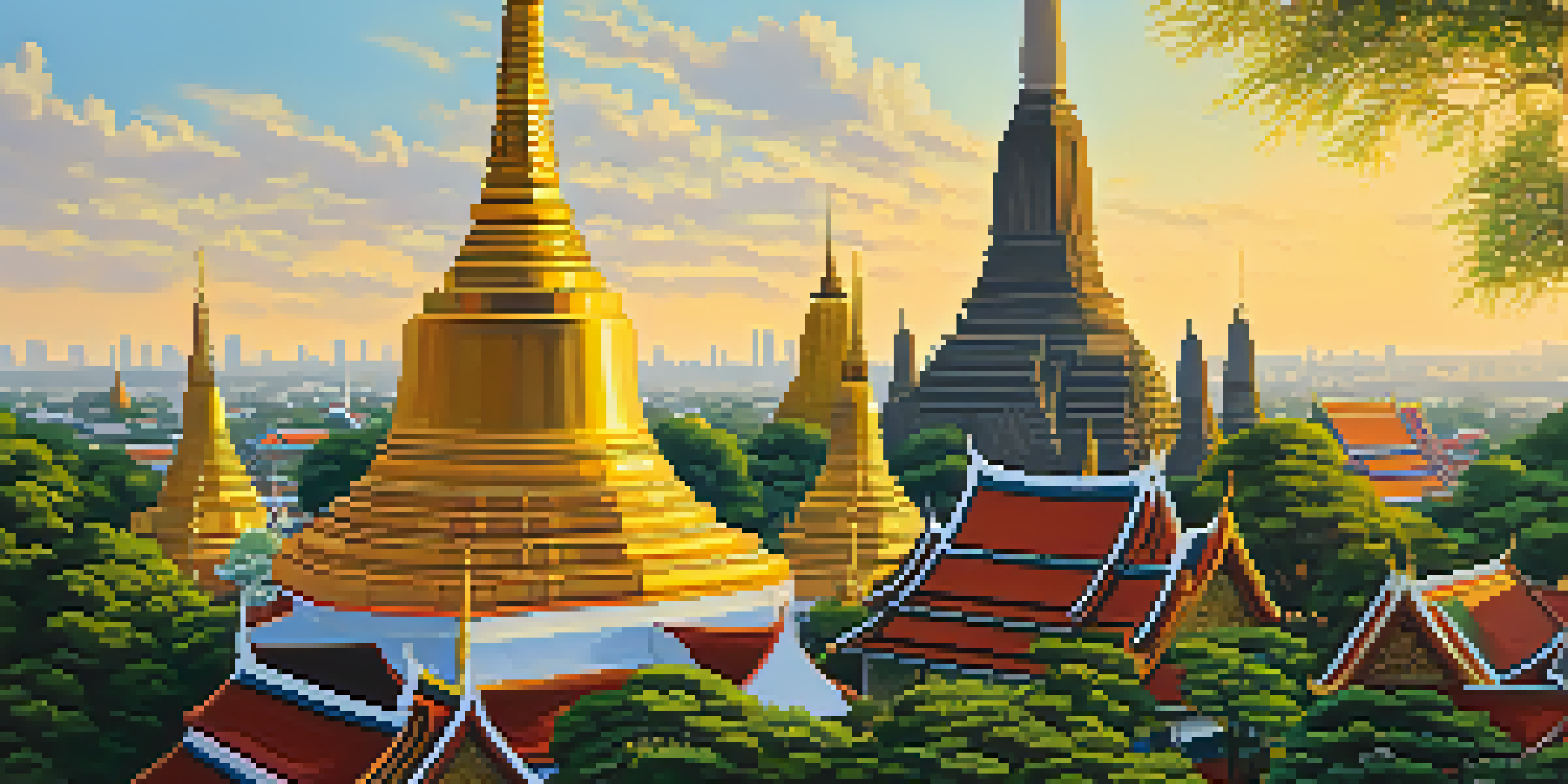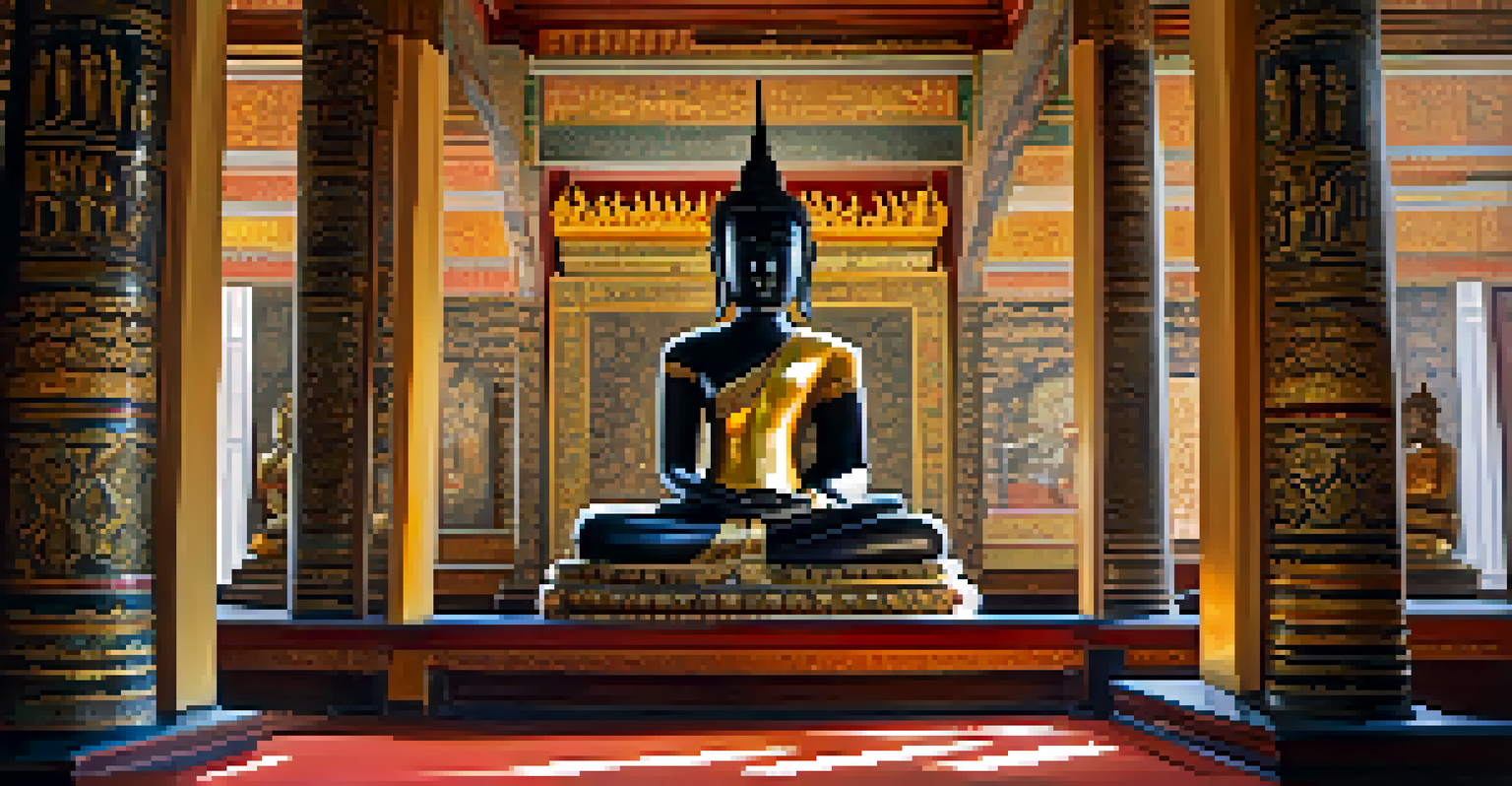Wat Pho: The Temple of the Reclining Buddha's Significance

An Overview of Wat Pho: A Cultural Landmark
Wat Pho, also known as Wat Phra Chetuphon, is one of Bangkok's oldest and most revered temples. Established in the 16th century, it holds a special place in Thai culture and spirituality. The temple complex is not just a religious site but also a center for education, particularly in traditional Thai medicine and massage.
The Temple is a place of peace, a sacred space for reflection and understanding.
As you step into Wat Pho, you're greeted by a vibrant atmosphere filled with the sounds of chanting monks and the scent of incense. The intricate architecture and serene gardens invite visitors to explore the rich history embedded within its walls. It’s a place where spirituality and artistry come together beautifully.
The temple's significance is further highlighted by its designation as a UNESCO World Heritage Site, recognizing its cultural importance. This status draws thousands of tourists each year, eager to experience its beauty and learn about Thai traditions.
The Reclining Buddha: A Marvel of Artistry
At the heart of Wat Pho lies the iconic Reclining Buddha statue, which measures an impressive 46 meters long. This magnificent statue depicts Buddha in a state of nirvana, symbolizing peace and ultimate liberation from suffering. Its sheer size and intricate details captivate every visitor who steps into the main hall.

The statue is adorned with gold leaf, and its feet are decorated with mother-of-pearl inlays that illustrate 108 auspicious symbols. Each symbol tells a story and adds layers of meaning to this already profound image. For many, this visual richness offers a chance to reflect on their own spiritual journey.
Wat Pho: A Cultural Landmark
Wat Pho is a revered temple in Bangkok, recognized for its rich history, educational role, and designation as a UNESCO World Heritage Site.
Beyond its physical beauty, the Reclining Buddha serves as a reminder of the teachings of Buddhism. Observing the statue encourages visitors to contemplate impermanence and the importance of mindfulness in daily life.
Historical Importance of Wat Pho in Thai Culture
Wat Pho has long been a center for Buddhist education and is home to a vast collection of Buddha images, totaling over 1,000. This rich array showcases the evolution of Thai art and religious practices through the centuries. Each image tells a story, reflecting the deep-rooted beliefs and values of Thai society.
Art is the most beautiful of all lies; it is the gateway to the soul.
The temple was also instrumental in the establishment of the first Thai university, which focused on traditional medicine and massage. This educational aspect highlights how Wat Pho has contributed to preserving and promoting Thai culture and health practices. Today, many visitors come to learn about Thai massage, a practice that has gained international acclaim.
Moreover, the temple plays a vital role in community gatherings and religious ceremonies, strengthening social bonds. Whether it's during festivals or daily prayers, Wat Pho remains a vital part of the community's spiritual life.
Visiting Wat Pho: A Journey Through Time
Visiting Wat Pho is like stepping back in time, where every corner tells a tale. From the majestic Chedis (stupas) that hold the ashes of kings to the tranquil gardens that offer a moment of peace, the temple invites exploration. Each visit can feel unique, depending on the time of day and the activities taking place.
Guided tours are available, which can enhance your experience by providing insights into the temple’s history and significance. These tours often share captivating anecdotes and local legends that bring the temple to life. Alternatively, wandering the grounds at your own pace allows for personal reflection and connection.
The Reclining Buddha's Significance
The iconic Reclining Buddha statue symbolizes peace and mindfulness, captivating visitors with its size and intricate details.
Don't forget to observe the daily rituals performed by the monks, as these practices are central to the temple's spiritual life. Witnessing these rituals can deepen your understanding of Thai Buddhism and its role in contemporary society.
Cultural Etiquette When Visiting Wat Pho
Respecting local customs is essential when visiting Wat Pho. As a place of worship, visitors are expected to dress modestly, covering shoulders and knees. This simple act of respect allows for a more meaningful experience and shows appreciation for the cultural significance of the temple.
Additionally, it’s important to be mindful of your behavior. Speaking softly and refraining from disruptive actions helps maintain the serene atmosphere that many come to seek. Remember, you're in a sacred space where spirituality is at the forefront of the community's life.
Lastly, always ask before taking photos, especially of the monks or during ceremonies. This demonstrates respect for their practices and beliefs, ensuring that your visit honors the cultural values of Wat Pho.
The Role of Wat Pho in Thai Medicine and Wellness
Wat Pho is renowned as the birthplace of traditional Thai massage, which is recognized for its therapeutic benefits. The temple houses a massage school where visitors can learn about this ancient practice. Many believe that experiencing a massage here is not just a luxury but a way to connect with Thai culture deeply.
Traditional Thai massage, known for its combination of acupressure and yoga-like stretching, promotes relaxation and well-being. This holistic approach to health reflects the broader principles of Buddhism, emphasizing balance and harmony in life. Many visitors leave feeling rejuvenated, both physically and spiritually.
Traditional Thai Massage Education
Wat Pho is the birthplace of traditional Thai massage, offering visitors a unique opportunity to connect with Thai culture and wellness practices.
By supporting the massage school at Wat Pho, you're also contributing to the preservation of this centuries-old tradition. It’s a wonderful way to engage with Thai culture while enhancing your own wellness journey.
Wat Pho's Influence on Thai Architecture and Art
The architectural style of Wat Pho has influenced countless temples throughout Thailand, showcasing the exquisite craftsmanship of Thai artisans. Its intricate designs and vibrant colors serve as a model for other structures, blending spirituality with artistic expression. This temple stands as a testament to the rich artistic heritage of the country.
Moreover, many artists and architects draw inspiration from Wat Pho’s unique blend of traditional and contemporary styles. They study its details, from the ornate decorations to the layout of the temple complex, which are essential elements in Thai architecture. A visit to Wat Pho can ignite creativity and appreciation for the arts.

As you explore, take note of the beautiful murals and sculptures that adorn the temple grounds. These artistic works not only serve a decorative purpose but also narrate stories from Buddhist teachings, making art an integral part of the spiritual experience.